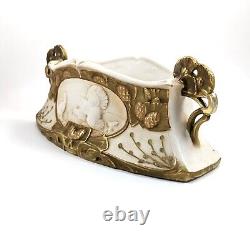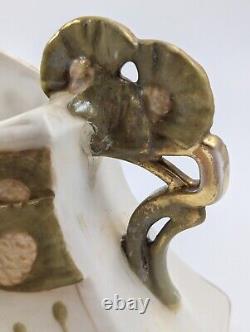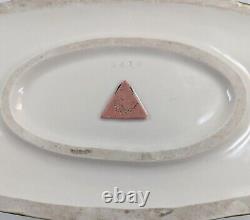Royal Dux Porcelain Vase, Art Nouveau, Large, Very Rare, c. 1918














Royal Dux Porcelain Vase, Art Nouveau, Large, Very Rare, c. This product data sheet is originally written in English. The vase is richly decorated with gold details such as handles, patterns in the lower and upper parts, and gold fir cones scattered all over. The use of gold plating in two colors gives the impression that some parts of the vase are made of bronze.
In the center on both sides, there are skillfully molded images on hunting themes. Two wood grouse and grouse with ripple look very natural. The shape of the vase is reminiscent of an old-fashioned hunting bag. The famous pink triangle of Royal Dux is on the base. It is with pieces like this that Royal Dux has earned its place among the best porcelain factories in the world.
Royal Dux porcelain is a type of fine porcelain first produced in the town of Duchcov, in what is now the Czech Republic, in the late 19th century. The company was founded in 1853 by Eduard Eichler and began producing fine porcelain pieces in 1860. In 1896, it was granted the status of a "purveyor to the imperial and royal court" by Emperor Franz Joseph I of Austria. During the late 19th and early 20th centuries, Royal Dux became known for its innovative designs and high-quality craftsmanship.
The company was particularly renowned for its figurines, which depicted a wide range of subjects, including animals, children, and historical figures. One of the most distinctive features of Royal Dux porcelain is its signature white matte glaze, which gives the pieces a soft, velvety texture.
The company also produced pieces with a glossy glaze and a range of decorative techniques, including hand-painted designs, gilding, and relief work. During the 20th century, Royal Dux continued to produce high-quality porcelain pieces but faced many challenges, including economic downturns, two world wars, and changes in consumer tastes. In the late 20th century, the company faced financial difficulties and was eventually nationalized by the communist government of Czechoslovakia. Today, the company continues to produce fine porcelain pieces, including figurines, vases, and other decorative objects.
Royal Dux porcelain remains highly prized by collectors and enthusiasts around the world for its beauty, craftsmanship, and historical significance. Dimensions: Width 36 cm, Depth 16 cm, Height 14.5 cm, Weight 1543 grams. Condition: Traces of restoration on one of the handles in places of attachment to the vase, loss of gilding consistent with age. Otherwise, the vase is in good antique condition. Please study the accompanying photographs carefully as they form an integral part of this description.Today, the company continues to produce fine porcelain pieces, including figurine.

